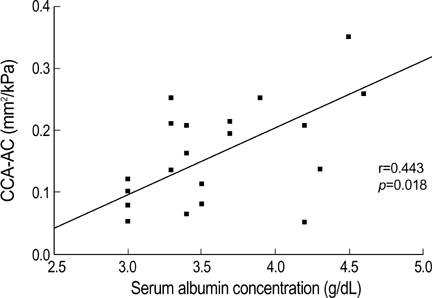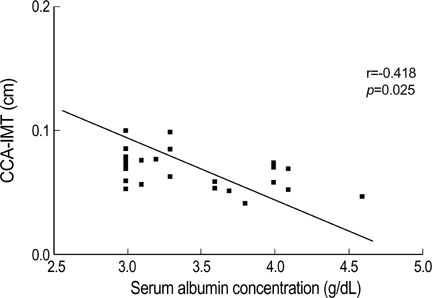J Korean Med Sci.
2005 Feb;20(1):70-74. 10.3346/jkms.2005.20.1.70.
The Relation Between Hypoalbuminemia and Compliance and Intima-media Thickness of Carotid Artery in Continuous Ambulatory Peritoneal Dialysis Patients
- Affiliations
-
- 1Department of Internal Medicine, College of Medicine, Chung-Ang University, Seoul, Korea. intmdoh@hanmail.net
- KMID: 1781728
- DOI: http://doi.org/10.3346/jkms.2005.20.1.70
Abstract
- The aim of this study was to identify the main factor affecting compliance and intima-media thickness of the elastic common carotid artery in continuous ambulatory peritoneal dialysis patients. Increased intima-media thickness and decreased arterial compliance are associated with elevated risk of cardiovascular disease. This study included 20 patients and 20 age- and sex- matched healthy control subjects. The compliance and intima-media thickness of the right common carotid artery within 1 cm to the bifurcation were measured three times using high-resolution B-mode echocardiography. Blood samples were obtained to measure levels of hemoglobin, phosphorus, total calcium, total CO2, serum albumin, C-reactive protein, serum total cholesterol, LDL- and HDL-cholesterol and triglycerides. We found that the compliance of common carotid artery was lower in the patient group than in the control group. In the patient group, the compliance of common carotid artery was positively correlated with serum albumin concentration, and intima-media thickness of common carotid artery was negatively correlated with serum albumin levels. Stepwise regression analysis showed that serum albumin concentration was independently related to the compliance of common carotid artery, suggesting hypoalbuminemia can independently give deleterious effects on the arterial wall in continuous ambulatory peritoneal dialysis patients.
MeSH Terms
-
Aged
Albumins/metabolism
Arteries/pathology
C-Reactive Protein
Carbon Dioxide
Cardiovascular Diseases
Carotid Arteries/*pathology
Carotid Artery, Common/pathology
Dose-Response Relationship, Drug
Echocardiography
Female
Hemoglobins/metabolism
Humans
Hypoalbuminemia/*pathology
Lipoproteins, HDL Cholesterol/blood
Lipoproteins, LDL Cholesterol/blood
Male
Middle Aged
Peritoneal Dialysis
Peritoneal Dialysis, Continuous Ambulatory/methods
Phosphorus/blood
Regression Analysis
Research Support, Non-U.S. Gov't
Serum Albumin/metabolism
Tunica Intima/pathology
Tunica Media/pathology
Figure
Reference
-
1. Raine AE, Margreiter R, Brunner FP, Ehrich JH, Geerlings W, Landais P, Loirat C, Mallick NP, Selwood NH, Thfreson G. Report on management of renal failure in Europe XXII, 1991. Nephrol Dial Transplant. 1992. 7:Suppl 2. 7–35.2. Blacher J, Guerin AP, Pannier B, Marchais SJ, London GM. Arterial calcifications, arterial stiffness, and cardiovascular risk in end-stage renal disease. Hypertension. 2001. 38:938–942.
Article3. Grobbee DE, Bots ML. Carotid artery intima-media thickness as an indicator of generalized atherosclerosis. J Intern Med. 1994. 236:567–573.
Article4. Lang RM, Fellner SK, Neumann A, Bushinsky DA, Borow KM. Left ventricular contractility varies directly with blood ionized calcium. Ann Intern Med. 1988. 108:524–529.
Article5. Fang J, Madganan S, Cohen H, Alderman MH. Measures of blood pressure and myocardial infarction in treated hypertensive patients. J Hypertens. 1995. 13:413–419.
Article6. Benetos A, Safar M, Rudnichi A, Smulyan H, Richard JL, Ducimetiere P, Guize L. Pulse pressure: A predictor of long-term cardiovascular mortality in a French male population. Hypertension. 1997. 30:1410–1415.7. Blacher J, Pannier B, Guerin AP, Marchais SJ, Safar ME, London GM. Carotid arterial stiffness as a predictor of cardiovascular and all-cause mortality in end-stage renal disease. Hypertension. 1998. 32:570–574.
Article8. Blacher J, Guerin AP, Pannier B, Marchais SJ, Safar ME, London GM. Impact of aortic stiffness on survival in end-stage renal disease. Circulation. 1999. 99:2434–2439.
Article9. Shoji T, Emoto M, Shinohara K, Kakiya R, Tsujimoto Y, Kishimoto H, Ishimura I, Tabata T, Nishizawa Y. Diabetes mellitus, aortic stiffness, and cardiovascular mortality in end-stage renal disease. J Am Soc Nephrol. 2001. 12:2117–2124.
Article10. London GM, Blacher J, Pannier B, Guerin AP, Marchais SJ, Safar ME. Arterial wave reflections and survival in end-stage renal failure. Hypertension. 2001. 38:434–438.
Article11. Laurent S, Boutouyrie P, Asmar R, Gautier I, Laloux B, Guize L, Ducimetiere P, Benetos A. Aortic stiffness is an independent predictor of all-cause and cardiovascular mortality in hypertensive patients. Hypertension. 2001. 37:1236–1241.
Article12. London GM. Cardiovascular disease in chronic renal failure: pathophysiologic aspects. Semin Dial. 2003. 16:85–94.13. Pignoli P, Tremoli E, Poli A, Oreste P, Paoletti R. Intimal plus medial thickness of the arterial wall: a direct measurement with ultrasound imaging. Circulation. 1986. 74:1399–1406.
Article14. Hayoz D, Rutschmann B, Perret F, Niederberger M, Tardy Y, Mooser V, Nussberger J, Waeber B, Brunner HR. Conduit artery compliance and distensibility are not necessarily reduced in hypertension. Hypertension. 1992. 20:1–6.
Article15. Sahn DJ, DeMaria A, Kisslo J, Weyman A. Recommendations regarding quantitation in M-mode echocardiography: results of a survey of echocardiographic measurements. Circulation. 1978. 58:1072–1083.
Article16. Devereux RB, Reichek N. Echocardiographic determination of left ventricular mass in man: anatomic validation of the method. Circulation. 1977. 55:613–618.
Article17. Levin A, Foley RN. Cardiovascular disease in chronic renal insufficiency. Am J Kidney Dis. 2000. 36:6 Suppl 3. S24–S30.
Article18. Beddhu S, Kaysen GA, Yan G, Sarnak M, Agodoa L, Omt D, Cheung AK. HEMO Study Group. Association of serum albumin and atherosclerosis in chronic hemodialysis patients. Am J Kidney Dis. 2002. 40:721–727.
Article19. Ridker PM, Rifai N, Pfeffer MA, Sacks FM, Moye LA, Goldman S, Flaker GC, Braunwald E. Inflammation, pravastatin, and the risk of coronary events arter myocardial infarction in patients with average cholesterol levels. Cholesterol and Recurrent Events (CARE) Investigators. Circulation. 1998. 98:839–844.20. Ridker PM, Hennekens CH, Buring JE, Rifai N. C-reactive protein and other markers of inflammation in the prediction of cardiovascular disease in women. N Engl J Med. 2000. 342:836–843.
Article21. Yeun JY, Levine RA, Mantadilok V, Kaysen GA. C-reactive protein predicts all-cause and cardiovascular mortality in hemodialysis patients. Am J Kidney Dis. 2000. 35:469–476.
Article22. Zimmermann J, Herrlinger S, Pruy A, Metzger T, Wanner C. Inflammation enhances cardiovascular risk and mortality in hemodialysis patients. Kidney Int. 1999. 55:648–658.
Article23. Cooper BA, Penne EL, Bartlett LH, Pollock CA. Protein malnutrition and hypoalbuminemia as predictors of vascular events and mortality in ESRD. Am J Kidney Dis. 2004. 43:61–66.
Article24. Foley RN, Parfrey PS, Harnett JD, Kent GM, Murray DC, Barre PE. Hypoalbuminemia, cardiac morbidity, and mortality in end-stage renal disease. J Am Soc Nephrol. 1996. 7:728–736.
Article25. Palmer RM, Ferrige AG, Moncada S. Nitric oxide release accounts for the biological activity of endothelium-derived relaxing factor. Nature. 1987. 327:524–526.
Article26. Radomski MW, Palmer RM, Moncada S. Endogenous nitric oxide inhibits human platelet adhesion to vascular endothelium. Lancet. 1987. 2:1057–1058.
Article27. Luik AJ, Spek JJ, Charra B, vanBortel LM, Laurent G, Leunissen KM. Arterial compliance in patients on long-treatment-time dialysis. Nephrol Dial Transplant. 1997. 12:2629–2632.
Article
- Full Text Links
- Actions
-
Cited
- CITED
-
- Close
- Share
- Similar articles
-
- Continuous Ambulatory Peritoneal Dialysis Patients Show High Prevalence of Carotid Artery Calcification which is Associated with a Higher Left Ventricular Mass Index
- Carotid ultrasound in patients with coronary artery disease
- Peritoneal-pleural leak improved by switching from continuous ambulatory peritoneal dialysis to automated peritoneal dialysis
- Relationship between Inflammatory Markers and High Resolution B-mode Carotid Artery Ultrasonography in Continuous Ambulatory Peritoneal Dialysis(CAPD) Patients
- Association between Carotid Artery Intima-Media Thickness and Stroke Risk Factors in Ischemic Stroke



